
|   |

|   |
Two surprises at Kadamb's A Quartet grand finale - Dr. S.D. Desai e-mail: sureshmrudula@gmail.com October 6, 2022 From a parable-like story to a probe into the collective social psychology to now, glimpses of a woman's silent emotional suffering. It is an ascending order of an unassuming exploration of a narrative through the Katha-k dance form. On Day Three (Sept 24) of Kadamb's A Quartet at Rhaen Basera, the young dancers, a day away from the woman-centric festival of Navaratri, presented Ekatra, which has significance at multiple levels.  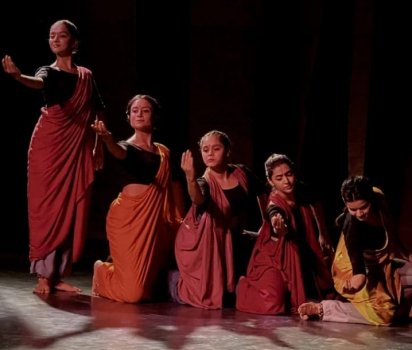 Ekatra During Navaratri, women invoke Goddess Shakti for power. In Ekatra, the dancers as characters get bold together to give voice to a delicate emotion not commonly expressed, probably not through the medium of dance. It is an anguished expression of a feeling they live with, it is suggested. The dance drama, performed with dedication and intensity, marks a departure in the impact a dance drama is known to make. Dramatic suggestion plays a major role. There is a striking sight of shirts lying in a straight line on the floor, all having patches of colour. This prompts viewers to think even before the performance begins. The story that unfolds gradually is based on shayaris on a woman's love - unfortunately, words drowned in the amplified sound for those in the front row. A voiceover (Mehul Surti) says, Ek stree pehle premi se prem karti hai, aur dheere dheere wo prem se prem karne lagti hai (A woman initially loves her lover and then gradually begins to love the idea of love.) This idea has a novel romantic appeal, but it is a bit amorphous and loaded with implications. Suggestion in a work of art leaves an impact. A modest effort, but the artistic expression, including even a line-drawing sketch, evokes poignance. Women outnumbered men in the audience. The poignance touches the audience and to a man (ekatra) they gave a spontaneous standing ovation at the end. A housewife who in her younger days was a sensitive actress whispered twice, "This must be seen by a wider audience." Joby Joy's recorded rhythm, controlled even where ardent, setting for the dancers the mood varying from segment to segment, gets integrally creative. The nonverbal complex emotional communication by the dancers through mudras, netrabhinaya, movement, stance, spins and the like, characteristic of Kathak, at times assumes a lyrical quality. Literally pouring out a cupful of coffee however could have been alright in a drama, one feels, not in a dance drama. And, trying to get it (memories) back in the cup is a bit farfetched. It is pretty promising that a young bunch of dancers even while trying to integrate drama in a dance piece explores a complex theme largely remaining within parameters of aesthetics. Seeing Mitali Dhruva from backstage execution responsibility to performance in a central role is a pleasure. 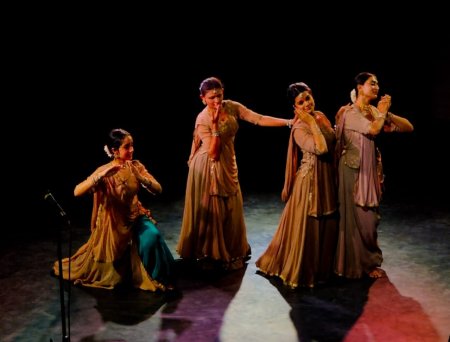
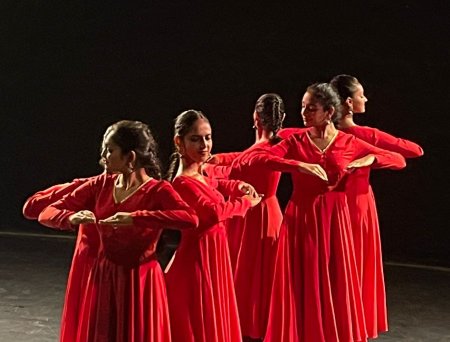 Drums and Drone Day Four (Sept 25) of Kadamb's A Quartet at Rhaen Basera sprang yet another surprise. Silence had replaced amplified musical sounds even before the commencement of the performance. Taking the hint earlier given, the audience that had turned up pretty early sat with quiet expectation. On the right of the large performance area was a special platform seating Joby Joy with a pair of tabla, teacher-cum-compere Rupanshi in spotless white, vocalist Jaimin Vaidya with a harmonium in front and the flutist Partha Sarkar. Resourcefully as the Narrator of Aaj Rung Hai (Vedika) engages the waiting audience for a while, without any noticeable hustle and bustle the Kathak legend who has made Kadamb Centre for Kathak Dance possible and renowned, the Guru of the budding Kathak dancers, Kumudini Lakhia enters and unassumingly prefers to occupy a seat comfortably right at the entrance, close to the platform. And the magic of the Four Quartet grand finale Drums and Drone begins. While the young performers, their faces glowing with a sense of accumulated joy at having been warmly received all these days, their aharya remarkably uniform with the striking red of their attire reflecting passion and energy, dance - bringing a smile to the young imaginative teacher and the nonagenarian Guru - the audience, predominantly young, including the dancers' parents, sitting chockablock, realize they are having a rare view of their kids' lively classroom activity and at the same time being keen participants, as it were, of a 'Kathak Appreciation Course (Basic)'! As the performers joyously demonstrate elements that define Kathak - thaat with its captivating stylized graceful posture, padhant with a mesmerizing recitation of rhythmic bols, tihai, spins, slides and sum ... leading to abhinaya on the spacious dance floor, the instrumental accompaniment on the platform gets energetically active and Rupanshi explains some of the terms, leaving space for the dancers also to get playful in action. 'This is our grammar,' enjoying her rapport with the viewers, she observes, 'and you saw elements of it applied to our visual narratives earlier.' The modest demonstration gave a taste of the Kadamb gharana - traditional and gracefully flowing, eminently viewable and tastefully entertaining, drawing designs in space - at times mentioned in discussions. The foursome (Mitali, Mansi, Vaishnavi, Natasha) that enters with Shaam ne bansi bajaayee … abhinaya piece, leaves a lasting impression with visual delicacy enhancing its shringara bhava. The drut laya bandishes and the Jugalbandi the two groups presented were delectable. 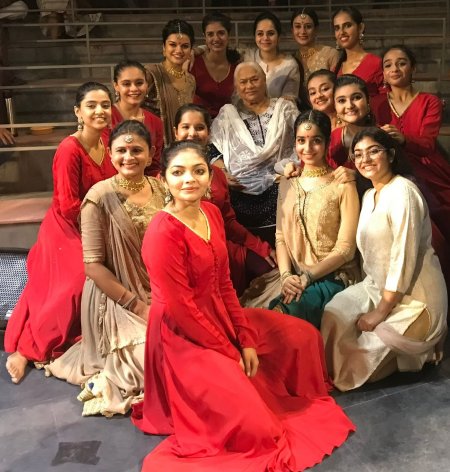 The dancers with Guru Kumudini Lakhia A Quartet by young dancers would remain in memory as a good initiative and it should continue. The audience response with shouts and yells for encouragement as in sports every couple of minutes needs to be moderated with insights. The concluding day's effort to educate the new audience holds promise. 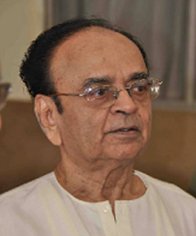 Dr. S.D. Desai, a professor of English, has been a Performing Arts Critic for many years. Among the dance journals he has contributed to are Narthaki, Sruti, Nartanam and Attendance. His books have been published by Gujarat Sahitya Academy, Oxford University Press and Rupa. After 30 years with a national English daily, he is now a freelance art writer. |